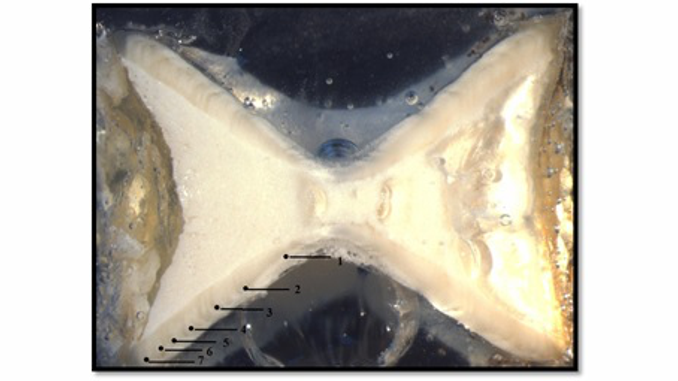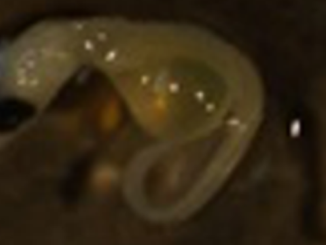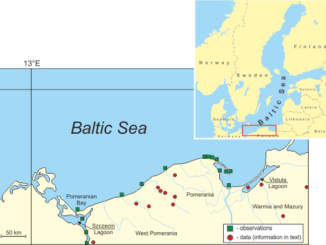
Paper category: Original research paper
Corresponding author: Koray Cabbar (koraycabbar_@hotmail.com)
DOI: 10.1515/ohs-2021-0011
Received: 23/09/2020
Accepted: 01/12/2020
Full text: here
Citation (APA style): Cabbar,K. & Yiğin,C.(2021).Biology of the thornback ray (Raja clavata Linnaeus, 1758) in the North Aegean Sea. Oceanological and Hydrobiological Studies,50(2) 115-127. https://doi.org/10.2478/oandhs-2021-0011
Abstract
The study deals with aspects of the population dynamics in the thornback ray (Raja clavata L., 1758), one of the most abundant cartilaginous fish caught in the North Aegean Sea. Females accounted for 73.08% and males 26.92% of all individuals. Total length of females and males ranged between 50.2 and 89.9 cm (disc width: 33.4–62.0 cm), and between 43.1 cm and 82.7 cm (disc width: 30.7–64.2 cm), respectively. Relationships between total length (TL) and total weight (TW), and between disc width (DW) and total weight (TW) were described by the equations: TW = 0.0041 TL3.10 and TW = 0.0178 DW3.03, respectively. Age data derived from vertebrae readings were used to estimate growth parameters using the von Bertalanffy function: L∞ = 101.71 cm, K = 0.18 y−1, t0 = −0.07 y for males and L∞ = 106.54 cm, K = 0.16 y−1, t0 = −0.28 y for females. The maximum age was 8 years for males and females. Total length at first maturity of males and females was 70.9 cm and 81.2 cm, respectively. Based on the gonadosomatic index and gonadal macroscopic observations, it was determined that the spawning period lasted throughout the year. Stomach content analysis showed that crustaceans (53.03% IRI) and teleosts (14.70% IRI) were the most preferred prey.
Acknowledgements
We are grateful to Dr. Mukadder Arslan İhsanoğlu and Dr. İsmail Burak Daban at the Marine Science and Technology Faculty, Çanakkale Onsekiz Mart University, for their collaboration in sampling and measurements.
References
Adda-Hanifi, M., Kherraz, A., Mouffok, S. & Boutiba, Z. (2017). Age and growth estimates of thornback ray, Raja clavata (Linnaeus, 1758) in Western Algerian coast (Chondrichthyes, Rajidae). IJB 10(6): 55–68. DOI: 10.12692/ijb/10.6.55-68.
Bertalanffy, L.V. (1938). A quantitative theory of organic growth (Inquiries on growth laws. II.). Hum. Biol. 10: 181–213.
Borges C.T., Olim, S. & Erzini, K. (2003). Weight-length Relationships for Fish Species Discarded in Commercial Fisheries of the Algorve (souther Portual). J. Appl. Ichthyol. 19: 394–396. DOI: 10.1111/j.1439-0426.2003.00480.x.
Bök, D.T., Göktürk, D., Kahraman, E.A., Alıçlı, Z.T., Acun, T. et al. (2011). Length Weight Relationships of 34 Fish Species from the Sea of Marmara Turkey. J. Anim. Vet. Adv. 10(23): 3037–3042. DOI: 10.3923/javaa.2011.3037.3042.
Braccini, J.M. & Chiaramonte, G.E. (2002). Reproductive biology of Psammobatis extenta. J. Fish Biol. 61: 272–288. DOI: 10.1006/jfbi.2002.204.
Brander, K. & Palmer, D. (1985). Growth rate of Raja clavata in the Northeast Irish Sea. Journal du Conseil – Conseil International pour l' Exploration de la Mer 42: 125–128.
Campana, S.E. (2014). Age determination of elasmobranchs, with special reference to Mediterranean species: a technical manual. Studies and Reviews. General Fisheries Commission for the Mediterranean. No. 94. Rome, FAO 2014. 38 p.
Cannizzaro, L.G., Garofalo Rizzo, L.D. & Gancitano, S. (1995). Raja clavata in the Sicilian Channel: Growth, distribution, abundance. Biol. Mar. Mediterr. 2: 257–262.
Capapè, C., Gue´lorget, O., Siau, Y., Vergne, Y. & Quignard, J.P. (2007). Reproductive biology of the thornback skate Raja clavata (Chondrichthyes: Rajidae) from the coast of Languedoc (Southern France, Northern Mediterranean). Vie et Milieu – Life and Environment 57: 83–90.
Capapé, C. & Quignard, J.P. (1974). Contribution à la biologie des Rajidae des côtes tunisiennes. 1. Raja miraletus, Linné, 1758: répartition géographique et bathymétrique, sexualité, reproduction, fécondité. Archives de Ínstitut Pasteur Tunis 51: 39–60.
Carlander, K.D. (1969). Handbook of freshwater fishery biology, volume 1. The Iowa State University Press, Ames: Iowa.
Carlander, K.D. (1977). Handbook of freshwater fishery biology 2. Life history data on centrarchidfishes of the United States and Canada. – Iowa State University Press, Ames, Iowa.
Demirhan, A.S., Engin, S., Seyhan, K. & Akamca, E. (2005). Some Biological Aspects of Thornback Ray (Raja clavata L., 1758) in the Southeastern Black Sea. Turk. J. Fish. Aquat. Sci. 5: 75–83.
Dulvy, N.K. & Reynolds John, D. (1997). Evolutionary transitions among egg–laying, live–bearing and maternal inputs in sharks and rays. Proceedings of the Royal Society B: Biological Sciences 264 (1386): 1309–1315. DOI: 10.1098/rspb.1997.0181.
Du Buit, M.H. (1976). The ovarian cycle of the cuckoo ray, Raja naevus (Müller and Henle), in the Celtic Sea. J. Fish Biol. 8: 199–207. DOI: 10.1111/j.1095-8649.1976.tb03943.x.
Ebeling, E. (1988). A brief survey of the feeding preferences of Raja clavata in Red Wharf Bay in the Irish Sea. p. 1–5 plus tables. ICES C.M. 1988/G:58, Demersal Fish Committee.
Ebert, D.A., Smith, W.D. & Cailliet, G.M. (2008). Reproductive biology of two commercially exploited skates, Raja binoculata and R. rhina, in the western Gulf of Alaska. Fish. Res. 94: 48–57.
Ebert, D.A. (2005). Reproductive biology of skates, Bathyraja (Ishiyama), along the eastern Bering Sea continental slope. J. Fish Biol. 66: 618–649.
Ellis, J.R., Pawson, M.G. & Shackley, S.E. (1996). The comparative feeding ecology of six species of shark and four species of ray (Elasmobranchii) in the North-East Atlantic. J. Mar. Biol. Assoc. U.K. 76: 89–106. DOI: 10.1017/S0025315400029039.
Ellis, J.R. & Shackley, S.E. (1995). Observations on egg-laying in the thornback ray. J. Fish Biol. 46(5): 903–904. DOI: 10.1111/j.1095-8649.1995.tb01613.x.
Fahy, E. (1991). The south eastern ray Raja spp. fishery, with observations on the growth of rays in Irish waters and their commercial grading. Irish Fisheries Investigations Series B, No. 37, 17pp.
Farias, I., Figueiredo, I., Moura, T., Gordo, S.L., Neves, A. et al. (2006). Diet Comparison of Four ray Species (Raja clavata, Raja brachyura, Raja montagiu and Leucoraja naevus) Caught Along the Portuguese Continental Shelf. Aquat. Living Resour. 19: 105–114. DOI: 10.1051/alr:2006010.
Filiz, H. & Mater, S. (2002). A Preliminary Study on Lenght-Weight Relationships for Seven Elasmobranch Species from North Aegean Sea, Turkey. EgeJFAS 19(3–4): 401–409.
Fischer, W. (1973). FAO Species Identification Sheets for Fishery Purposes, Mediterranean and Black Sea. In W. Fıscher (Ed.), Fishing Area 37 Volume II. FAO of the UN Rome.
Fischer, W., Bauchot, M.L. & Schnider, M. (1987a). Fishes FAO d’identification des espe’ces pour lesw besoins de la pe’che. (Re’vision 1). Me’diterrenele et mer Noir. Zone de pe’che 37. Vol. I. Ve’ge’taux et inverte’bre’s. Publication pre’pare’e par la FAO, re’sultat du’n accord entra la FAO et la Commission des Communaute’s Europe’ennes (Project GCP/INT/422/EEC) finance’e conjointement par ces deux organizations. Rome, FAO, Vol.1.
Fischer, W., Bauchot, M.L. & Schnider, M. (1987b). Fishes FAO d’identification des espe’ces pour lesw besoins de la pe’che. (Re’vision 1). Me’diterrenele et mer Noir. Zone de pe’che 37. Vol. I. Ve’ge’taux et inverte’bre’s. Publication pre’pare’e par la FAO, re’sultat du’n accord entra la FAO et la Commission des Communaute’s Europe’ennes (Project GCP/INT/422/EEC) finance’e conjointement par ces deux organizations. Rome, FAO, Vol.2: 761–1530.
Gallagher, S., Marras, W.S., Litsky, A.S. & Burr, D. (2005). Torso flexion loads and fatigue failure of human lumbosacral motion segments. Spine 30: 2265–2273. DOI: 10.1097/01.brs.0000182086.33984.b3.
Hamlett, W.C. & Koob, T.J. (1999). Female reproductive system. In W.C. Hamlett (Ed.), Sharks, Skates and Rays (pp. 398–443). Baltimore, The John Hopkins University Press.
Holden, M.J., Rout, D.W. & Humphreys, N. (1971). The rate of egg laying by three species of ray. Journal du Conseil International pour I'Exploration de la Mer 33(3): 335–339. DOI: 10.1093/icesjms/33.3.335.
Holden, M.J. (1972). The Growth Rates of Raja Brachyura, R. Clavata and R. Montagui as Determined From Tagging Data. Journal du Conseil International pour l'Exploration de la Mer 34(2): 161–168. DOI: 10.1093/icesjms/34.2.161.
Holden, M.J. (1975). The Fecundity of Raja clavata in British Waters. ICES J. Mar. Sci. 36(2): 110–118. DOI: 10.1093/icesjms/36.2.110.
Holden, M.J. & Raitt, D.F.S. (1974). Manual of Fisheries science. Part 2: Methods of Resource Investigation and Their Application. FAO Fisheries Technical Report 115(1).
Hyslop, E.J. (1980). Stomach Content Analysis- A Review of Methods and Their Application. J. Fish Biol. 17: 411–429. DOI: 10.1111/j.1095-8649.1980.tb02775.x.
Ilkyaz, A.T., Metin, G., Soykan, O. & Kinacigil, H.T. (2008). Length–weight relationship of 62 fish species from the Central Aegean Sea, Turkey. J. Appl. Ichthyol. 24: 699–702. DOI: 10.1111/j.1439-0426.2008.01167.x.
İşmen, A., Özen, Ö., Altınağaç, U., Özekinci, U. & Ayaz, A. (2007). Weight–length relationships of 63 fish species in Saros Bay. Turkey. J. Appl. Ichthyol. 23: 707–708. DOI: 10.1111/j.1439-0426.2007.00872.x.
Jardas, I. (1973). A contribution to our knowledge of the biology and ecology of thornback ray (Raja clavata L.) and brown ray (Raja miraletus L.) in the Adriatic. Acta Adriat. 15: 1–42.
Janez, J.A. & Sueiro, M.C. (2009). Oviposition rate of the fanskate Symterygia bonapartii (Elasmobranchii, Rajidae) (Müller & Henle, 1841) held in captivity. Pan-Am. J. Aquat. Sci. 4(4): 580–582.
Kadri, H., Marouani, S. Saïdi, B., Bradi, N.M., Bouaïn, A. et al. (2014a). Age, Growth, Sexual Maturity and Reproduction of the Thornback ray, Raja clavata (L.) of the Gulf of Gabes (South-central Mediterrannean Sea). Mar. Biol. Res. 10(4): 416–425. DOI: 10.1080/17451000.2013.797584.
Kadri, H., Marouani, S., Bradai, N.M. & Bouain, A. (2014b). Diet and Feeding Strategy of Thornback ray, Raja clavata (Chondrichthyes: Rajidae) from the Gulf of Gabes (Tunisia – Central Mediterranean Sea). J. Mar. Biol. Assoc. U.K. 94(7): 1509–1516. DOI: 10.1017/S0025315414000587.
Karachle, K.P. & Stergiou, I.K. (2010). Food and Feeding Habits of Nine Elasmobranch Species in the North Aegean Sea. Rapp. Comm. İnt. Mer Medit. 39.
Kusher, D.I., Smith, S.E. & Cailliet, G.E. (1992). Validated age and growth of the leopard shark, Triakis semifasciata, with comments on reproduction. Environ. Biol. Fishes 35: 187–203.
Lesser, J.H.R. (1967). Studies on ray stocks of the southeastern Irish Sea. Unpublished MSc Thesis, University of Wales, Bangor Wales.
Maia, C., Serra-Pereira, B., Erzini, K. & Figueiredo, I. (2015). How is the Morphology of the Oviducal Gland and of the Resulting Egg Capsule Associated with the Egg Laying Habitat of Rajidae Species? Environ. Biol. Fishes 98: 2037–2048. DOI:10.1007/s10641-0150425-1.
Marquardt, D. (1963). An Algorithm for Least-Squares Estimation of Nonlinear Parameters. SIAM J. Appl. Math. 11: 431–441.
Mendes, B., Fonseca, P. & Campos, A. (2004). Weight-length Relationships for 46 Fish Species of the Portuguese West Coast. J. Appl. Ichthyol. 20: 355–361. DOI: 10.1111/j.1439-0426.2004.00559.x.
Morato, T., Solá, E., Grós, P.M. & Menezes, G. (2003). Diets of Thornback ray (Raja clavata) and Tope Shark (Galeorhinus galeus) in the Bottom Longline Fishery of the Azores, Northeastren Atlantic. NMFS Scientific Publications Office. Fish. Bull. 101: 590–602.
Murduchay-Boltouski, F.D. (1969). Detection of Black Sea and Azov Sea Fauna. In V.A. Volyaniski (Ed.). vol. 3.
Oddone, M.C. & Vooren, C.M. (2005). Reproductive biology of Atlantoraja cyclophora (Regan 1903) (Elasmobranchii: Rajidae) off southern Brazil. ICES J. Mar. Sci. 62: 1095–1103. DOI: 10.1016/j.icesjms.2005.05.002.
Oddone, M.C. & Velasco, G. (2004). Size at maturity of the smallnose fanskate Sympterygia bonapartii (Muller and Henle, 1841) (Pisces, Elasmobranchii, Rajidae) in the SW Atlantic. ICES J. Mar. Sci. 61: 294–297. DOI: 10.1016/j.icesjms.2003.11.004.
Paesch, L. & Oddone, M.C. (2008). Change in size-at-maturity of the yellownose skate Dipturus chilensis (Guichenot, 1848) (Elasmobranchii: Rajidae) in the SW Atlantic. Neotrop. Ichthyol. 6: 223–230. DOI: 10.1590/S1679-62252008000200009.
Pawson, M. & Vince, M. (1999). Management of shark fisheries in the northeast Atlantic. In R. Shotton (Ed.), Case Studies of the Management of Elasmobranch Fisheries. Rome: FAO Fisheries Technical Paper 1: 1–46.
Pawson, M.G. & Ellis, R.J. (2005). Stock Identity of Elasmobranchs in the Northeast Atlantic in Relation to Assessment and Management. J. Northwest Atl. Fish. Sci. 35: 173–193. DOI: 10.2960/J.v35.m480.
Pinkas, L.M., Oliphant, S. & Iverson, I.L.K. (1971). Food habits of albacore, bluefin tuna, and bonito in Californian waters. State of California the Resources Agency Department of Fish and Game, Fish Bulletin 152: 1–105.
Prager, M.H., Saila, S.B. & Recksiek, C.W. (1987). FISHPARM: A microcomputer program for parameter estimation of nonlinear models in fishery science. Old Dominion University, Norfolk, Virginia, Technical Report (87–10): 1–37.
Quiniou, L. & Rabarison, A.G. (1979). Variations du regime alimentaire de raies de la baie de Douarnenez (Raja montagui Fowler, 1910; Raja brachyura Lafont, 1873; Raja clavata L., 1758). Cybium 3e série 7: 27–39.
Rosa, A., Menezes, G., Melo, O. & Pinho, R.M. (2006). Weight-length relationships of 33 demersal fish species from Azores archilago. Depertamento de Oceanografia e Pescas, Universidade dos Açores, PT-9901-862 Horta, Portugal.
Ryland, S.J. & Ajayi, O.T. (1984). Growth and Population Dynamics of Three Raja Species (Batoidei) in Carmarthen Bay, British Isles. ICES Journal of Marine Science 41(2): 111–120.
Sağlam, H. & Ak, O. (2012). Reproductive Biology of Raja clavata (Elasmobranchii: Rajidae) from Southern Black Sea Coast Around Turkey. Helgol. Mar. Res. 66: 117–126.
Sağlam, H. & Başçınar, S.N. (2008). Feeding Ecology of Thornback ray (Raja clavata Linnaeus, 1758) on the Turkish Coast of the South-Eastern Black Sea. Mar. Biol. Res. 4: 451–457. DOI: 10.1080/17451000802233393.
Šantić, M., Rada, B. & Pallaoro, A. (2012). Diet and Feeding Strategy of Thornback ray Raja clavata. J. Fish Biol. 81: 1070–1084. DOI: 10.1111/j.1095-8649.2012.03382.x.
Serra-Pereira, B., Figueiredo, I., Bordalo-Machado, P., Farias, I., Moura, T. et al. (2005). Age and Growth of Raja clavata Linnaeus, 1758 – Evaluation of Ageing Precision Using Different Types of Caudal Denticles. ICES CM Elasmobranch Fisheries Science N:17.
Serra‐Pereira, B., Afonso, F., Farias, I., Joyce, P., Ellis, M. et al. (2011). The development of the oviducal gland in the rajid thornback ray, Raja clavata, Helgol. Mar. Res. DOI: 10.1007/s10152‐010‐0232‐1.
Skomal, G.B. & Natanson, L.J. (2003). Age and growth of the blue shark, (Prionace glauca) in the North Atlantic Ocean. Fish. Bull. 101: 627–639.
Smale, M.J. & Cowley, P.D. (1992). The feeding ecology of skates (Batoidea: Rajidae) off the Cape South coast, South Africa. South Afr. J. Mar. Sci. 12: 823–834. DOI: 10.2989/02577619209504744.
Sparre, P. & Venema, S.C. (1992). Introduction to tropical fish stock assessment. Part 1. Manual FAO Fisheries Technical Paper No: 306/1, Rev. 1, 376.
Stehmann, M. & Bürkel, D.L. (1984). Rajidae. In P.J.P. Whitehaed, M.-L. Bauchot, J.-C. Hureau, J. Nielsen & E. Tortonese (Eds.), Fishes of the North-eastern Atlantic and the Mediterranean (pp. 163–196). Vol. I, UNESCO.
Tanaka, S., Cailliet, G.M. & Yudin, K.G. (1990). Differences in growth of the blue shark, Prionace glauca: Technique or population? In H.L. Pratt, S.H. Gruber & T. Taniuchi (Eds.) Elasmobranchs as Living Resources: Advances in the Biology, Ecology, Systematics, and the Status of the Fisheries. NOAA Technical Report NMFS 90: 177_87.
Taylor, A.J. & Holden, M.J. (1964). The preparation and use of vertebrae for age determination in ray. Vol. 145 ICES Document CM near Northern Seas Committee, pg. 4.
Templeman, W. (1987). Differences in sexual maturity and related characteristics between populations of thorny skate (Raja radiata) from the Northwest Atlantic. J. Northwest Atl. Fish. Sci. 7: 155–167.
Torres, B., Morey, G. & Tomas, J. (2005). Interpretation of vertebral growth marks as annuli in the sandbar shark Carcharhinus plumbeus: Analysis of vertebrae of captive specimens. J. Mar. Biol. Assoc. U.K. 85: 1167–1170.
Tüik, 2018. Türkiye İstatistik Kurumu, Su Ürünleri İstatistikleri https://biruni.tuik.gov.tr/medas/?kn=97&locale=tr.
(In Turkish).
Valls, M., Quetglas, A., Ordines, F. & Moronta, J. (2011). Feeding ecology of demersal elasmobranchs from the shelf and slope off the Balearic Sea (western Mediterranean). Sci. Mar. 75(4): 633–639.
Walker, P.A. (1999). Fleeting images. Dynamics of North Sea ray populations. Unpublished doctoral dissertation. University of Amsterdam.
Wheeler, A. (1978). Key to the fishes of northern Europe. Frederick Warne, London.
Whitehead, P.J.P., Bauchot, M.L., Hureau, J.C., Nielsen, J. & Tortonese, E. (Eds) (1986a). Fishes of the North-Eastern Atlantic and the Mediterranean. Vol. 1. Richard Clay Ltd, UK: 511–1007.
Whitehead, P.J.P., Bauchot, M.L., Hureau, J.C., Nielsen, J. & Tortonese, E. (Eds) (1986b). Fishes of the North-Eastern Atlantic and the Mediterranean. Vol. 2. Richard Clay Ltd, UK: 1008–1474.
Whittamore, M.J. & McCarthy, D.I. (2005). The Population Biology of the Thornback ray, Raja clavata in Caernarfon Bay, North Wales. J. Mar. Biol. Assoc. U.K. 85: 1089–1094. DOI: 10.1017/S0025315405012130.
Windell, J.T. & Bowen, S.H. (1978). Methods for The Study of Fish Diets Based on Analysis of Stomach contents. In T. Bagnel (Ed.), Methods for the Assessment of Fish Production in Fresh Waters. 3rd edn. Oxford: Blackwell.
Yeldan, H., Avşar, D. & Manaşırlı, M. (2008). Kuzeydoğu Akdeniz’deki Deniz Tilkisi Raja clavata (Linnaeus, 1758)’nın Bazı Biyolojik Özellikleri. EgeJFAS 25(3): 221–228.
Yemişken, E. (2017). Doğu Akdeniz Balıkçılık Bölgelerinde Trol Balıkçılığının Kıkırdaklı Balık Türleri Üzerine Etkisinin Karşılaştırılması. Unpublished doctoral dissertaton. İstanbul Üniversitesi, Türkiye. (In Turkish).
Yığın, C.Ç. & İşmen, A. (2009). Lenght-Weight Relationship for Seven Rays from Saros Bay (North Aegean Sea). J. Appl. Ichthyol. 25: 106–108. DOI: 10.1111/j.1439-0426.2008.01161.x.
Yığın C.Ç. & İşmen, A. (2010). Diet of Thornback ray (Raja clavata Linnaeus, 1758) in Saros Bay (The North Aegean Sea). Rapp. Comm. Int. Mer Médit. 39.



